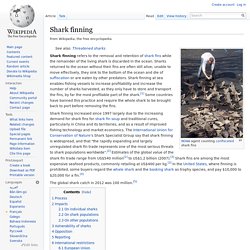

History of Shark Fin Soup – Shark Truth. The story goes that shark fin soup was created by an emperor in the Sung Dynasty (AD 968) who wanted to show how powerful, wealthy and generous he was to his banquet guests.

Serving the expensive dish came to be seen as a sign of respect. “The Big 4” The dish became a popular delicacy and is now known for being part of what is known as the Big 4 – a set of dishes representing different things in Chinese culture such as prosperity and health at a traditional dinner banquet. Often reserved for special occasions like weddings, the Big 4 consists of: Abalone [bào]Sea cucumber [shēn]Shark fin [chì]Fish maw [dǔ] Species. Why Sharks Are Endangered — SEEtheWILD Wildlife Conservation Travel.
Why Sharks Are Endangered Commercial Fishing The biggest threat to sharks, skates, and rays is the overfishing and over-consumption of their meat, fins, and cartilage.

Shark fins are particularly sought after for traditional Chinese medicine and shark fin soup which is considered a delicacy in Asia. Shark Conservation. The United States places a high priority on achieving effective conservation and management of sharks.

Their life history characteristics make most sharks particularly susceptible to overexploitation. Because many sharks are apex predators and can be vital to the health of the ecosystems in which they occur, their conservation and management represents an integral part of ecosystem-based fisheries management.Sharks are currently taken in directed fisheries and as bycatch. In the North Atlantic, for instance, directed tuna and swordfish fisheries result in the bycatch of blue sharks. In the central Pacific, purse seine fisheries that set on floating objects and fish aggregating devices can also take a large number of sharks. The Shark Trust - Stop Shark Finning. Shark Finning.
STOP SHARK FINNING. Shark Finning. Human beings are skilled at justification.

Every year humans slaughter over 100 million sharks yet we depict them as vicious and blood-thirsty killers. No more than 12 people a year are killed by sharks worldwide. In fact is more dangerous to play golf than to swim in the ocean with sharks. More golfers are struck by lightning and killed each year than the total number of shark fatalities. Many more humans are struck and killed by boats every year than are attacked by sharks. Yes, we also kill them for their teeth and jaws, and we kill them for shark leather for shoes and belts.
We kill sharks because of our fear of them, for food, for sport, and most disturbing of all - so that some of us can make a tasteless, expensive soup to impress our family and friends. Shark Education - Shark Finning Facts. 7 reasons to band shark finning. Fins are sliced off of sharks while their live bodies are tossed back into the ocean like trash.

Here are 7 reasons why this practice should be banned. 1. Our most ancient species are endangered. Sharks have existed since before the dinosaurs and pre-date humans by hundreds of millions of years. Once kings of natural selection, sharks are now facing extinction due to finning. Environmental Remediation Products. Shark Finning: Sharks Turned Prey. A fisherman holds a freshly cut dorsal fin from a scalloped hammerhead shark (Sphyrna lewini).

Every year, humans kill an estimated 100 million sharks. Removing sharks in large numbers can have ripple effects that throw entire ecosystems out of balance. Credit: © Jeff Rotman/jeffrotman.com by Caty Fairclough Sharks have been feared hunters ever since people first observed them swimming in the vast ocean. Shark fins are tempting targets for fishermen because they have high monetary and cultural value. Many fishermen prefer to practice shark finning instead of bringing whole sharks to the market because the fins are far more valuable than the rest of the body, sometimes selling for as much as $500 a pound ($1,100 a kilogram).
However, the animal cruelty implications are not the only reason to stop this practice. MaryEllen and Paul, Flickr Such dramatic population plunges are not only dangerous for sharks but also for entire ecosystems. Shark finning. Shark finning refers to the removal and retention of shark fins while the remainder of the living shark is discarded in the ocean.

Sharks returned to the ocean without their fins are often still alive; unable to move effectively, they sink to the bottom of the ocean and die of suffocation or are eaten by other predators. Shark Finning · Learn · Australian Marine Conservation Society. Shark fishing across the globe is the single biggest threat to shark populations.

With up to an incredible 73 million sharks killed every year, predominantly for their fins, it’s no wonder that the IUCN has assessed that one-third of all open ocean shark species are threatened with extinction. Huge and increasing demand for shark fins gives sharks the dubious privilege of being amongst the most valuable animals in the sea; it has also made them the most vulnerable. Sharks are considered ‘keystone species’, which means that as top predators, they are extremely important in maintaining the balance in marine ecosystems. Removing too many sharks from an eco-system can lead to a monumental shift in the equilibrium between predators and prey all the way through the food chain. But the value of sharks doesn't just lie in their body parts.
With no demonstrably sustainable shark fisheries currently in operation, AMCS does not support targeted shark fishing, in Australia or the world.